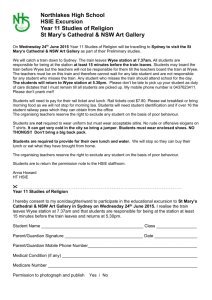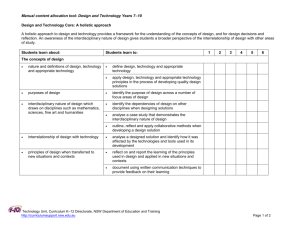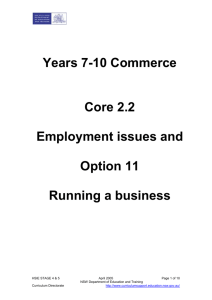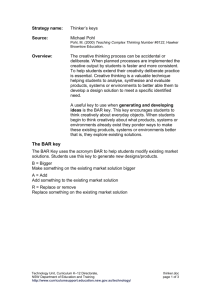Employment issues and running a business
advertisement
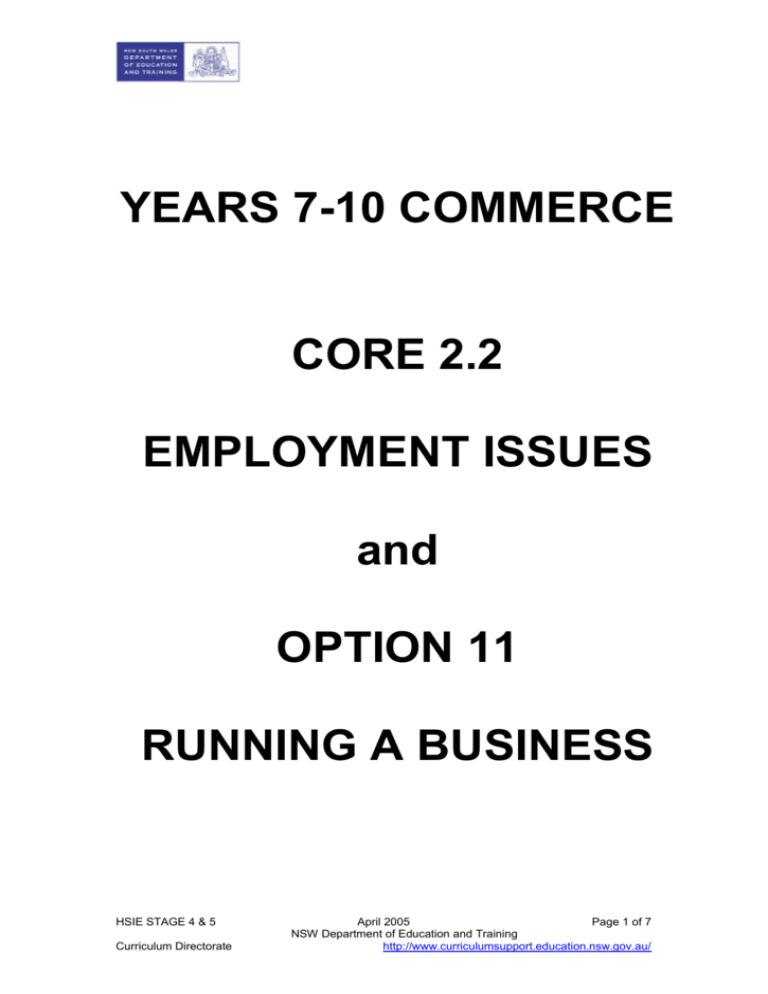
YEARS 7-10 COMMERCE CORE 2.2 EMPLOYMENT ISSUES and OPTION 11 RUNNING A BUSINESS HSIE STAGE 4 & 5 Curriculum Directorate April 2005 Page 1 of 7 NSW Department of Education and Training http://www.curriculumsupport.education.nsw.gov.au/ PLEASE READ THIS STATEMENT ABOUT THE PROGRAMS AND THEIR PURPOSE Officers from Curriculum K-12 Directorate have been working with a number of schools on a programming project. The purpose of the project has been to take the programming focus off the restrictive, often slavish, following of every dot point in the old syllabuses to focus on the big picture learning and to incorporate the elements of the Quality teaching document into student tasks to increase the significance of the learning for students. The programs are NOT lesson plans and do not contain the excessive detail and overlays of some programs that have developed in the HSIE subjects. They have a simple format that provides a small number of large tasks to cover the learn about and learn to statements for each topic. In using these programs students take more responsibility for their learning, work more in groups and have greater choice about what case studies and examples they engage. Teachers can act more as facilitators, but will still need to intervene in the learning to teach explicitly concepts, skills and terminology when students find difficulty within particular tasks. All the tasks can be used for assessment for or assessment of learning purposes. Teachers can use the tasks to provide feedback to students and assess the products and processes of the task for the purpose of recording data that will be used for school reporting purposes. When using the tasks in these ways for assessment, there is no need to create additional assessment tasks and end of topic tests are not needed because teachers will have already the assessment information needed for school reporting. Schools can add their own resources and vary the ICT suggestions, within the syllabus requirements, to match their school resources. While every attempt has been made to cover all the syllabus requirements, the units have not as yet been trialed in classrooms. Feedback is welcomed and adjustments will be made to improve the units in response to feedback. Watch for updates. John Gore CEO, HSIE NOTE: This particular program has been written as a model to demonstrate a combined unit of work with an emphasis on work and employment. HSIE STAGE 4 & 5 Curriculum Directorate April 2005 Page 2 of 7 NSW Department of Education and Training http://www.curriculumsupport.education.nsw.gov.au/ Topic Commerce Stage 5 Combined unit Core Part 2.2: Employment Issues Option 11: Running a Business Reflects intent of Work, Employment & Enterprise statement Time: 40 Hours (16 wks) 1. Work first 4 weeks 2. Business 12 weeks runs concurrently with 3. Employment last 4 wks Focus Students become actively engaged in planning, organising & running a business focusing on the commercial & legal aspects of employment & the work environment. Outcomes A student: 5.1 applies consumer, financial, business, legal & employment concepts & terminology on a variety of contexts 5.2 analyses the rights & responsibilities of individuals in a range of consumer, financial, business, legal & employment contexts. 5.3 examines the role of law in society 5.4 analyses key factors affecting commercial & legal decisions 5.5 evaluates options for solving commercial & legal problems & issues 5.6 monitors & modifies the implementation of plans designed to solve commercial & legal problems & issues 5.7 researches & assesses commercial & legal information using a variety of sources 5.8 explains commercial & legal information using a variety of forms 5.9 works independently & collaboratively to meet individual & collective goals within specified timelines Suggested ICT Database: record results of surveys- local businesses, local employment needs Spreadsheets: prepare business budget Multimedia: Powerpoint presentation, animated advertisement, 30 second video commercial to launch or market product or service Graphics/desk top publishing: produce brochure or flyer for product or service Electronic communication: access information on starting & running a business, employment opportunities, business case studies, design a web page to market a product or service Word processing: use to prepare information for other applications Resources ABS website www.abs.gov.au Employment Related Skills Logbook Business Enterprise Centres www.becsmallbiz.com.au/services.htm Business Entry Point www.business.gov.au NSW Dept of State & Reg Dev http://www.smallbiz.nsw.gov.au/interest/young Telstra Business Starters www.telstra.com.au/business-starters/index.htm 'Making It Happen' Introduction to Enterprise Education Kit DEETYA Computer-based Technologies in HSIE: Project Management pp75-80 Job guide Vocational Learning in HSIE 'Changing Labour Market' Paul Baker Powerpoint presentation det website DEWR Job Outlook www.workplace.gov.au ACTU Worksite for Schoolshttp: http://www.worksite.actu.asn.au/ Destination 2020 http://www.tgmag.ca/byws/game.htm Jobsearch website career quiz www.jobsearch.com.au UAC (Universities Admission Centre Guidebook Centrelink Myfuture website HSIE STAGE 4 & 5 Curriculum Directorate April 2005 Page 3 of 7 NSW Department of Education and Training http://www.curriculumsupport.education.nsw.gov.au/ Teacher Note: This combined unit begins with the workplace, changing work patterns and types of employment (Core Part 2.2 Employment Issues). Issues of unemployment lead to considerations of self-employment and the requirements of running a small business enterprise (Option 11 Running a Business). The unit concludes with aspects of employment issues relating to running a business, such as employment contracts, taxation and superannuation and employment relations. This third section can be completed concurrently with tasks in running a business enterprise or as a discreet task at the end of the unit. Teaching and learning activities Assessment: The activities require students to demonstrate their learning and are all assessment for learning activities. Some activities might be selected and included in a school assessment schedule for assessment of learning. Employment Agency Learn abouts and learn tos 1. Work The Workplace Changing work patterns investigate changing work patterns & discuss impacts on individual & society research & evaluate stereotypes of employment patterns propose strategies to address workplace issues and concerns Benefits of education & training for employment identify the range of skills & benefits of employment programs Types of employment casual, part time, full time, self-employed voluntary & unpaid identify the range of employment options for young people examine the advantages & disadvantages associated with particular types of jobs for men & women Unemployment discuss implications of unemployment for individuals & society Task 1 You work in an employment agency. You have been asked to investigate the employment situation in your suburb/town and write a report for your manager. Search the Positions Vacant in the local newspaper, community noticeboards and the internet for 1 week. Draw up a table to list the jobs available based on occupation, gender, age, full time, part time or casual work. List the employer requirements for each of the jobs. Go on to the ABS website. Compare job opportunities from your survey to ABS statistics. Write a report to your manager which outlines the job opportunities for men, women and young people in your town/suburb. Include in your report whether jobs are full time, part time or casual hours. Make a special note of groups they you think may have difficulty in finding a job. Task 2 Form groups of 4-5 to be a team in the employment agency. Each team has to develop a training manual to help clients seek employment. Refer to the Employment Related Skills Logbook. Outline the general skills required in the workplace Develop a proforma for writing a resume Outline the do’s and don’ts of going for interview, including dress and presentation Develop a program Coping with Unemployment to support clients as they look for a job Prepare a talk/presentation on the services the employment agency offers, including a role play to demonstrate interview techniques. Task 3 Each student in the class is an employees in the employment agency and needs to contribute to the preparation of charts for a display at the school Careers Expo. The following information should be included on a number of posters: Possible school to work pathways that students can HSIE STAGE 4 & 5 Curriculum Directorate April 2005 Page 4 of 7 NSW Department of Education and Training http://www.curriculumsupport.education.nsw.gov.au/ follow. Range of occupations showing description of jobs, personal requirements, changes over time, pay, working conditions, education and training requirements, skills required, career path Posters to counter stereotypes of employment patterns Community volunteer work - organizations seeking volunteers eg Meals in Wheels, what they do, what they need, employment related skills that are developed Students are to complete a competency sheet for the School to Work Employment-Related Skills Logbook 2. Running a Business Enterprise Small Business Enterprise Being an Entrepreneur Reasons for being self-employed identify the advantages & disadvantages of being self employed Form groups of 6-10 students to plan and operate a hypothetical business. Students are to elect a CEO, secretary, marketing manager, finance manager, operations manager and assistants. All members should contribute to the planning and operation of the business and cooperate to make decisions. Required skills and personal characteristics assess the required skills & personal characteristics for success as a business owner needed Operating a business set up and run a simulated or school-based business Planning for success Selecting business opportunities - market research, location, demographics, competition, target markets identify the opportunities for small business operations examine the range of opportunities for setting up a small business evaluate the likely success of small business opportunities Selecting the appropriate structure - sole trader, partnership, private company, incorporated association describe the key features of each organisational structure select an appropriate structure for particular situations Arranging finance investigate & evaluate the range of finance options prepare a loan application or a simple prospectus Establishing a new or purchasing an existing business - location, staffing, new, established, franchising, equipping describe the main steps in establishing a HSIE STAGE 4 & 5 Curriculum Directorate Task 4 Each member of the group is an investor in the business. To increase the chances of success, the group needs to allocate tasks to develop and print a simple business proposal which includes the following: an introduction which identifies the advantages and disadvantages of being in business, and outlines the skills and personal characteristics of the owners a description of the good or service to be produced the brand name and logo to be used a description of the market research strategy which determines the location, demographics, target market and competitors an outline of the possible legal structures and the reasons for using the one selected an outline of the local, state and federal laws and regulations with which the business must comply a budget which estimates the costs of production, selling price, source of funds the steps taken to establish the business including location, staffing, and setting up operations In planning the business students should: engage in team building exercises access local Business Enterprise Centres investigate websites such as Telstra Business Starters, Business Entry Point, It's Your Business, Smallbiz investigate student case studies from ‘Making It Happen’ CD-ROM visit appropriate or related small businesses Task 5 In operating the business, students are to: prepare printed advertising such as posters, pamphlets, newspaper/magazine advertisements and business cards April 2005 Page 5 of 7 NSW Department of Education and Training http://www.curriculumsupport.education.nsw.gov.au/ new or purchasing an existing business Business Operation Meeting regulations - local, state, federal identify the regulations impacting on a business operation Selling products select appropriate marketing strategies for promoting a business make a 30 second video commercial contribute a stand at a class trade show provide a group oral presentation to launch the product and introduce their business prepare a written report of the business operations including the financial records which need to be kept and plans for the future of the business Students are to complete a competency sheet for the School to Work Employment-Related Skills Logbook Maintaining records - revenue statement, balance sheet, cash flow, taxation records construct & analyse key business documents Risk management - planning for the future identify & develop strategies to minimise risk to avoid insolvency & bankruptcy 3. Employment Aspects of employment issues relating to running a business identify, evaluate & report on employment issues & processes related to a business Types of Employment Contracts awards, enterprise agreements, individual workplace agreements, common law contracts use the internet to investigate the types of employment contracts discuss the advantages & disadvantages of each type of employment contract rights & entitlements of casual, part-time & full-time employment research the employment conditions of casual, part-time, full-time employees & contractors Taxation reasons for taxes, types of taxes describe the services funded by taxation explain the relationship between taxation, income & government-funded services processes of paying taxes complete a basic tax return & tax declaration Superannuation identify the obligation of employers towards employees in relation to superannuation discuss the advantages & disadvantages of superannuation as a saving/investment option This part of the unit can be completed as a discrete task or concurrently in developing the small business. The Human Resources Manager is employing staff. Task 6 As the Human Resources Manager of the business you are responsible for recruiting staff. Prepare a report for the CEO on how you would recruit staff. determine the positions required for the business prepare 1 job advertisement including a job description, qualifications, remuneration outline the criteria for selection including questions to be asked at interview explain the advantages and disadvantages of different types of employment contracts and suggest the best type of employment contract for the position Task 7 As a team of 4 students, devise an induction program and compile a handbook for new employees draw a diagram to show the management structure outline the legal rights and responsibilities of full time, part time and casual employees including working conditions and types of leave obtain an income tax declaration and complete it as an example for employees Identify the obligation of employers towards employees in relation to superannuation determine the superannuation to be paid by the employer and employee explain the protection provided by anti-discrimination laws identify the relevant trade union and outline their role in a possible dispute. develop grievance procedures including a flow chart showing the steps in making a complaint Task 8 HSIE STAGE 4 & 5 Curriculum Directorate April 2005 Page 6 of 7 NSW Department of Education and Training http://www.curriculumsupport.education.nsw.gov.au/ Employment Relations Legal issues relating to the workplace occupational health & safety, antidiscrimination & unfair dismissal, redundancy & retraining, privacy, outsourcing, piecework research a current employment relations issue that affects different groups in society identify ethical & unethical workplace practices & investigate the impact of these practices discuss the extent to which antidiscrimination laws protect individuals in the workplace Role of unions & employer groups identify the role of unions & employer groups assess the changing role of unions & employers groups Resolving disputes - grievance procedures, negotiation, mediation, conciliation, arbitration identify a range of dispute resolution methods explain a possible dispute resolution process propose strategies to address workplace issues & concerns HSIE STAGE 4 & 5 Curriculum Directorate You have been voted to the position of grievance officer for the workplace. The following complaint has been lodged with you. A young Lebanese female employee has been consistently praised for the past 3 years by her supervisor for her excellent work. Recently a young anglo Australian male who joined the firm in the past 12 months was promoted to the position of team leader over her. She now has to report to him on a daily basis. She has lodged a complaint to you the grievance officer. Your job is to investigate the case and write a report to the Human Resource Manager. Your investigations should include: Protection of employees with anti-discrimination laws Evidence of ethical and unethical work practices The role of the relevant union in resolving the dispute The dispute resolution method used The outcome of negotiations Students are to complete a competency sheet for the School to Work Employment-Related Skills Logbook April 2005 Page 7 of 7 NSW Department of Education and Training http://www.curriculumsupport.education.nsw.gov.au/

